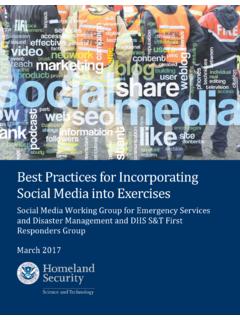Transcription of EMERGENCY MEDICAL SERVICES - IAFF Main
1 IAFFI nternational Associationof Fire Fighters EMERGENCY MEDICAL SERVICESP rivatization and PrehospitalEmergency MEDICAL ServicesMonograph 1iEmergency MEDICAL ServicesPrivatization and Prehospital EMERGENCY MEDICAL ServicesMonograph 1 department of EMERGENCY MEDICAL ServicesInternational Association of Fire Fighters, AFL-CIO, CLCC opyright 1997 by the International Association of Fire Fighters. This publicationis protected by copyright. No part of it may be reproduced, stored in a retrieval system,or transmitted in any form or by any means, electronic, mechanical, photocopying,recording, or otherwise without written permission from the International Associationof Fire Fighters, department of EMERGENCY MEDICAL Standard Book Number: 0-942920-22-8 ForewordToday, more than 80% of fire departments perform some level of emergencymedical SERVICES (EMS), making professional fire fighters the largest group of providersof prehospital EMERGENCY care in North America.
2 No other organization public orprivate is capable of providing prehospital EMERGENCY response as efficiently andeffectively as fire departments. Fire department operations are geared to rapidresponse, whether it is for EMS or fire suppression. Cross-trained/dual-role fire fightersare trained to aggressively attack their work whether it involves fire, rescue, or medicalemergency. It is no surprise that study after study has shown that fire department -basedprehospital EMERGENCY MEDICAL care systems are superior to other provider we look to the future of prehospital EMERGENCY MEDICAL care, however, we mustre-evaluate our role in the context of a rapidly evolving MEDICAL care system. Drawingon what we have learned during the past century, we must create a vision for the futureof fire-based EMS. This vision must include legislation for the protection of fire-basedsystems, public education, prevention, and the possibly expansion of the scope ofpractice for paramedics.
3 This vision must consider the effects of managed careorganizations on prehospital EMS, as well as revenue recovery for the SERVICES firefighters perform. We should support legislation to protect fire-based systems from thethreat of privatization and to protect the citizens we serve by preserving the nation'suniversal EMERGENCY access number, 9-1-1. The information in this series of monographsis designed to guide local fire department leaders through the process of developing avision for the future of a fire-based EMS system. This monograph is the first in the seriesand addresses privatization of EMERGENCY MEDICAL SERVICES . This monograph should beuseful for IAFF members and fire service leaders who are preparing to contend withprivate ambulance service role of the professional fire fighter is constantly changing. We are multi-faceted first responders, answering not only fire calls but also rescue, hazardousmaterials, and EMERGENCY MEDICAL calls.
4 By confronting the challenge of change, wecan continue to meet the needs of the communities we serve and do what we do best protect property and save A. SchaitbergerGeneral PresidentAcknowledgmentsIAFF department OF EMERGENCY MEDICAL SERVICESLori Moore, MPH, EMT-P, DirectorThe IAFF would like to acknowledge the department of EmergencyMedical SERVICES staff, specifically Jonathan Moore and Sandy Miller, fortheir work in the development of this IAFF also wishes to recognize the members of the IAFF EMSC ommittee for their editorial review and support:James L. Hill, District 7 Vice President, Co-ChairDominick F. Barbera, District 12 Vice President, Co-ChairRobert B. McCarthy, President, PFF of MassachusettsPatrick Cantelme, President, IAFF Local 493, Phoenix, AZDan Fabrizio, President, IAFF Local 2, Chicago, ILMark A. Lloyd, President, IAFF Local 385, Omaha, NERichard L. Mayberry, President, IAFF Local 522, Sacramento, CAGary Rainey, Secretary, IAFF Local 1403, Metro-Dade Co.
5 , FLRonald L. Saathoff, President, IAFF Local 145, San Diego, CAInternational Association of Fire Fighters AFL-CIO, CLCD epartment of EMERGENCY MEDICAL Services1750 New York Avenue, NWWashington, DC 20006(202) 737-8484(202) 737-8418 (FAX)Privatization and Prehospital EMST able of 1 WHAT IS PRIVATIZATION?.. 2 Contracting Out .. 2 Public/Private Partnership .. 2 THE CONCEPT OF PRIVATIZING ESSENTIAL PUBLICSERVICES .. 3 FIRE BASED VERSUS PRIVATE EMS - A DIFFERENCE OFPHILOSOPHIES AND SERVICE .. 5 Fire-Based EMS .. 5 Private EMS .. 5 Response Time Interval .. 6 Patient Transport .. 7 PUBLIC SUBSIDIES TO PRIVATE CORPORATIONS .. 8 DEVELOPING PUBLIC/PRIVATE PARTNERSHIPS .. 10 PROBLEMS WITH 14 PRIVATE AMBULANCE PROVIDERS: THE CORPORATIONS 16 American MEDICAL Response, Inc. (AMR) .. 16 18 Rural/Metro Corporation .. 19 PRIVATIZATION 20 PROPONENTS OF 23 American Ambulance Association (AAA).
6 23 Other Organizations .. 26 GLOSSARY .. 28 Appendix 1. Privatization of EMERGENCY MEDICAL SERVICES officials and citizens may be faced with a decision regarding themost appropriate provider of prehospital EMERGENCY MEDICAL SERVICES intheir community. The options for EMERGENCY MEDICAL service (EMS)providers may include the fire department , a private ambulance service,a combination of the two, or various other provider types. As communitiesevaluate their EMERGENCY MEDICAL care needs, they may focus exclusivelyon patient transportation since third party payers for EMERGENCY medicalservices reimburse only for transport. Research on patient survival,however, has demonstrated that rapid, on-scene MEDICAL interventionproduces the best patient outcomes. Therefore, designing a community sEMS system should be approached from a global perspective. Thougheach component (initial response, ALS, transport, etc.)
7 Must be consideredindividually, the system must function as a single entity with all theelements fully is no secret that in some cases, a private ambulance provider couldprovide the transport component of an EMS system more cheaply than apublically-provided system. It is also known, however, that a privateprovider cannot optimally provide an entire EMS system more efficientlynor more effecively than a fire department . The infrastructure of the localfire department can be exploited to provide optimal response foremergency MEDICAL calls. Community leaders should examine theresources available for EMS within their fire department . The communityshould then determine the role fire fighters will play in the overall EMSsystem. That role may include delivery of the entire makers must consider not only the cost associated with EMSprovision, but also response time, quality of service, associated revenue,and patient outcome in selecting a provider and designing an effective,cost-efficient EMS describes the process of shifting the provision of a publicservice from the government to a private sector enterprise.
8 Private sectorenterprises include nongovernmental firms, partnerships, joint ventures,corporations, or other legal entities engaged in commercial activity are two approaches of privatization that are likely to impact thedelivery of public provided fire-based prehospital EMERGENCY medicalservices contracting out and public/private out may be defined as a governmental entity employing aprivate sector enterprise and its employees to perform a service, ratherthan directly performing the service. The government may still pay andassume responsibility for the service but hire a private company toprovide the service. In the United States, contracting out is the mostfrequently used form of privatization. It may also be referred to asoutsourcing. A recent variation to contracting out is managed competition. This contracting process permits a governmental agency to prepare aproposal and submit a bid to compete with private bidders for the right toprovide a public-sector service.
9 The process is usually defined in a request for proposal (RFP) released by the local public/private partnership may be defined as a coordinated, collaborativeeffort between a private company and a government agency for theprovision of essential SERVICES to the public. This partnership should bemutually beneficial to all parties concerned, including the OUTPUBLIC/PRIVATEPARTNERSHIPWHAT ISHAT ISwhatWHATWHAT IS PRIVATIZATION?3 The primary goal of a private corporation is return on investment. If it failsto thrive financially, the private corporation faces ruin. Only individualswho have an ownership interest in the corporation (a corporation sshareholders) have a right to vote on corporate matters. The corporationis designed to regulate private interest and exists mainly for nature of private industry must be recognized by community leadersconsidering contracting with a private ambulance provider for a criticalmunicipal function, such as EMERGENCY MEDICAL SERVICES .
10 Public officialsshould also recognize the effectiveness and the economic value of the firedepartment providing a whole EMS system compared to contracting pieces of a system to a private company. When comparing systemcost, the marginal cost of the fire department providing emergencymedical SERVICES should be compared to the total cost of a privatecompany providing a complete EMS system without fire departmentinvolvement. This costing method provides a clear picture of the true costof the entire EMS , the General Accounting Office (GAO) was asked toidentify lessons learned by, and related experiences of, state and citygovernments in implementing privatization efforts. The document releasedfollowing this study (GAO-GGD-97-48) provides a profile for profile includes six components that should exist for privatization tooccur. The components include the following.












